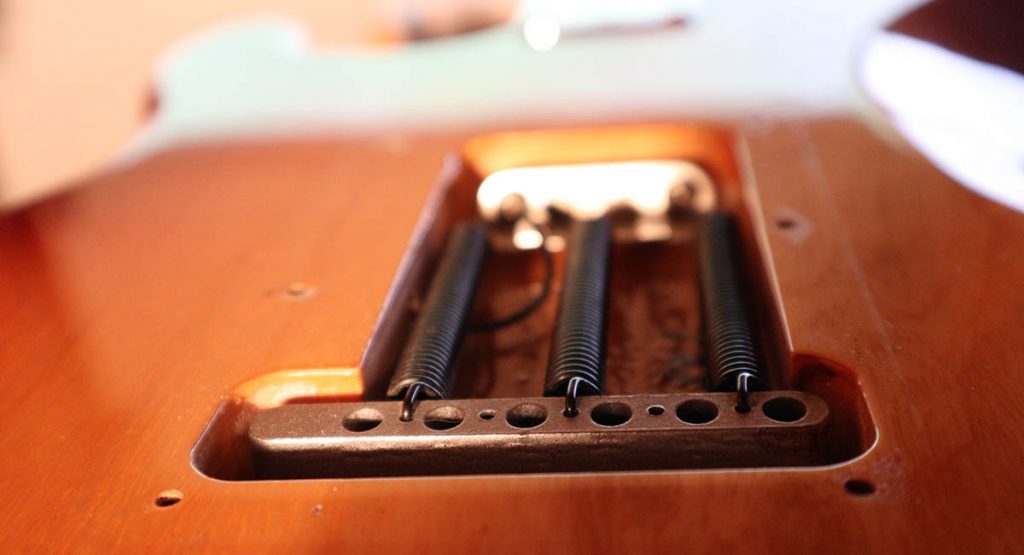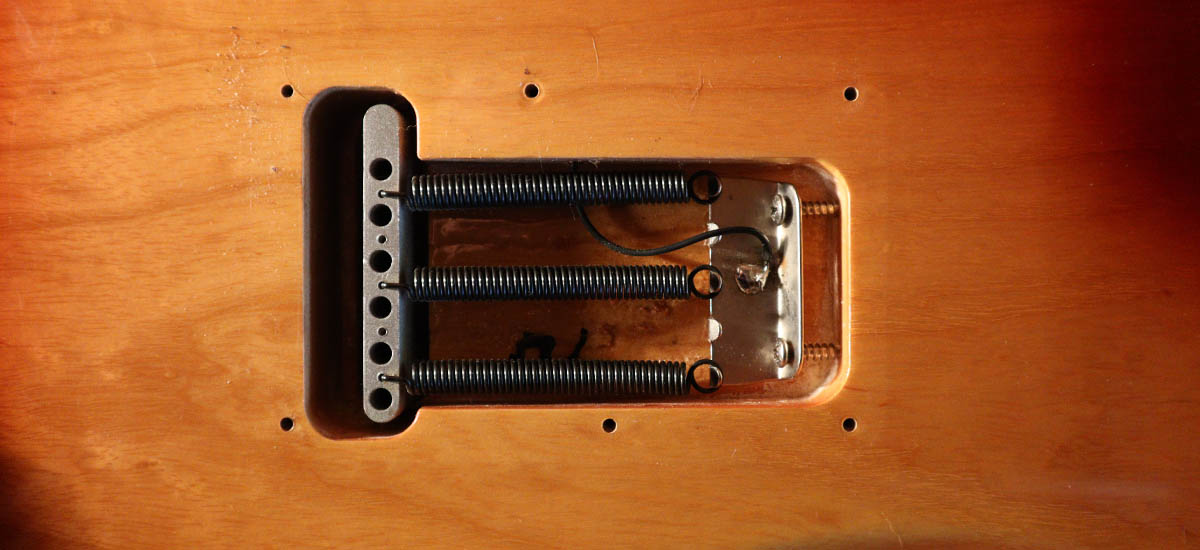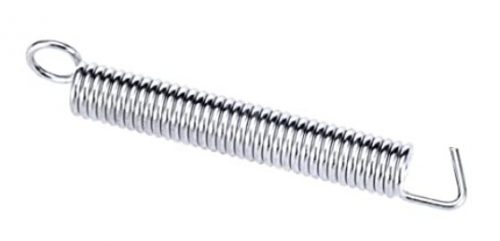One of the greatest features of the iconic Fender Stratocaster is the synchronized tremolo system which built upon the revolution in music centered around the electric guitar. The guitar tremolo allows for a range of subtle vibrato to gut punching dive bombs, increasing the instrument’s expressive ability.
No doubt, the trem on the Fender Strat is both iconic and potentially frustrating because of the complexity it introduces into a guitar’s setup. In this article, we explore the three ways (floating, decking, or blocking) to set up the Stratocaster’s bridge and the pros and cons of each.
For a full, step-by-step guide to setting up a Stratocaster check out this tutorial here.
Table of Contents
Tremolo vs. Vibrato
First let’s get this out of the way. The effect that a tremolo system on a guitar creates is actually vibrato not tremolo. Vibrato is defined as a slightly tremulous effect imparted to vocal or instrumental tone for added warmth and expressiveness by slight and rapid variations in pitch. [1]
The tremolo of a guitar allows the player to lower the pitch of the note played, and sometimes increase it as well. Used in a subtle way gives us a vibrato effect.
Tremolo on the other hand is the variation of volume as opposed to pitch. This produces a different form of wavering or warbling achieved by effects pedals, amps, or clever use of the guitar’s volume control.
So why is the Strat’s bridge called a tremolo? In 1954 when Fender released the Stratocaster, it was billed as having a “synchronyzed tremolo system.” And according to Fender, “Indeed, one of the very first Strat advertisements in 1954 led with the headline Tremolo Action.” [2]
Fender incorrectly used that terminology from the beginning and it just stuck. And now it’s common to hear a moving bridge called a tremolo, or trem for short.
The Three States of the Stratocaster Trem
There are three possible configurations of the Stratocaster Tremolo: Floating, Decked, and Blocked.
Floating the trem allows the bridge to be pushed down which loosens the string tension, and pulled up which tightens the string tension.
Decking the trem allows for the bridge to only be pushed down. When the note returns to its original pitch, the bottom of the bridge plate will be flush with the top of the guitar.
Blocking the trem physically locks the bridge in place not allowing for any movement.
All three options change the characteristics and feel of the guitar. No option is right or wrong, they present different pros and cons and the best option will depend on your own personal style of playing and preference for feel.
Next, we’ll get into the specifics of each setup and discuss the pros and cons of each.

Required Watching
Darrell Braun has a great video where he goes into detail with side by side comparisons for each of these three setups. Watch the video below to dispel the myths and answer some questions especially regarding sustain and trem configuration.
Strat Trem Setting for Maximum Sustain
It’s clear from the video above that blocking the Strat’s trem will achieve the most sustain from your guitar. Second best is decking the trem, and the least amount of sustain will come from setting your trem up to float.
The reason for this is because the blocked trem allows for more string vibration to enter the body of the guitar. The guitar’s body holds the most mass of the instrument and this vibration, initiated by the strings, in turn feeds the vibration back into the strings as the note or notes fade. This conservation of energy results in the string vibrating longer.
I want to ask a different question however. Does slightly longer sustain in an electric guitar really matter? I don’t think so.
It’s rare that you ever play long notes and let them ring until they fade out. And if that is the effect you’re going for, a sustain that is too long could be detrimental to the effect of notes dropping off that you’re going for.
Typical rhythm guitar strums notes and chords way before they fade out naturally. Lead playing uses even less long notes that ring until they fade. My point is that pure sustain isn’t something that is used very often by itself.
This isn’t to say that sustain is a bad quality. No one is going to tell you that more sustain is a bad thing in a guitar. However, sustain for the sake of sustain isn’t useful or something worthwhile to chase after.
Floating Tremolo
A floating tremolo means that the bridge is balanced between the tension of the strings, and the tension of the bridge springs. The bridge pivots around the attachment point (either two posts as in the modern bridge type or 6 screws in the vintage style, see below for examples of Strat bridge styles) which is the only physical connection the bridge has to the body of the guitar.
It’s no surprise that this configuration has the least amount of pure sustain. The vibrations have only a tiny surface area in which to be transferred into the body of the guitar. If sustain is the thing you’re going for, this configuration is probably not for you.
A floating tremolo also means that you can bend notes both down (loosening the string) and up (tightening the string).
Jeff Beck is a great example of this. His bridge is set up quite high allowing for a whole step of upward bend on the first string. This allows for upward bends, but also for a very controlled vibrato effect.
Watch the first song of Jeff Beck’s live performance at Ronny Scott’s
This is a great example of that vibrato technique. Watch how he keeps the tremolo arm in his right hand and with a very light touch either dives notes or creates vibrato.
There are three major downsides of floating the Fender Strat trem. These are out of tune bends, and performance ending string breaks, and the inability to play in different tunings.
Because the bridge is balanced perfectly for the tension of strings, any slight change will change the bridge’s position and therefore the string height, and even changing string gauge requires a full bridge setup.
Bending Strings
When you play two notes at the same time and bend one of those strings, a floating bridge will allow the non-bended string to loosen and go flat. To hear this for yourself, pluck a note then bend the string next to it without plucking it. You’ll hear the original not go flat as the bridge is pulled nutword from the bending pressure.
For some players, this is a stylistic addition which adds to the expression of their bends. For others this is an annoying inconsistency where the guitar is out of tune and difficult to control.
String Breaks
An often overlooked downside of a floating bridge is that a broken string will send the other 5 strings way out of tune. In most situations this isn’t a big deal, but playing live this is unacceptable.
With a decked or blocked bridge, a broken string has no effect on the tension of the remaining strings and will stay in tune. However, a floating bridge cannot take a broken string and if playing live, the guitar needs to be swapped out to continue playing.
If playing live regularly, consider decking the bridge, or lightening the string attack as to minimize the number and possibility of broken strings.
Inability to Play in Multiple Tunings
Again, a floating bridge balances perfectly the tension of the springs in the back to the tension of the strings. Changing tuning from standard to ½ step down, or drop D will completely change the position of the bridge and require retuning the entire guitar.
More often than not, a different tuning will cause other unwanted issues. For instance, if a Strat setup for standard is put in drop D tuning, the reduced tension on the bass side of the bridge can cause a binding effect where the spring tension is much greater on the treble side.
To Float or Not To Float

This is a personal choice and the cons of floating your Strat bridge may outweigh the advantages if you have a heavy touch and play live gigs on a regular basis.
If you want to wobble and warble the guitar around like Jeff Beck then you’ll need to deal with the potential downsides of floating your Strat trem.
However, if you only gig with one guitar the answer is much easier. Your performance would come to a grinding halt if you broke a string, which is always a possibility.
Decking Tremolo
Decking the tremolo is one of the most popular ways to set up a Stratocaster bridge. Countless guitar players have used this configuration and for good reason. Though you do not get the full pivot range of the bridge, the bridge becomes much more stable allowing for alternate tunings, string breaks, and string bends all without detuning the other strings.
Decking a tremolo gives you the best features of a hardtail style bridge like the Les Paul with the added dive bombing abilities that were so successfully used by Jimi Hendrix and many others who helped push the limits of rock music and guitar playing.
How to Deck a Strat Tremolo
The standard configuration for a Stratocaster is three springs with a slight float in the bridge. A common method for decking a tremolo is to add 2 more springs for the max number of 5, and tighten the claw bracket until the bottom of the bridge plate fits snug to the top of the guitar.
The standard 3 springs can be used but you might find that you like a bit more pressure pulling the bridge back towards the body. If this is the case experiment with adding springs. These springs from Amazon are the ones I use:
Strat Bridge Springs 10 Pack, Amazon
As long as the bottom of the bridge stays on the top of the guitar when tuned up to the desired pitch, any additional tension put on the springs only affects the pressure needed on the tremolo arm to achieve the desired dive bomb effect.
If you bend strings a lot, tune the guitar up to pitch and then bend the strings like you normally would. Watch the back of the bridge to make sure that the spring tension is enough to keep it tight to the body of the guitar.
While you can’t go too tight with the bridge claw plate (plate that holds the springs to the body), be careful not to strip the screws that go into the body of the guitar. Make sure to use a correctly sized screwdriver and work slowly.
The downside of decking the Strat trem is that you can no longer get a subtle vibrato effect using a light touch on the trem arm. While that may be a big deal to some people, others may not even notice.
Blocking Tremolo
As we learned in the video posted above, a blocked trem will provide the most sustain. If we really need all of that sustain is an argument for another article. However, if you don’t use a tremolo system there is really no reason not to block the bridge.
Blocking involves cutting a wedge of material, preferably a hardwood like maple, mahogany, alder, or ash, that fits tightly against the metal bridge block and the back of the bridge cavity. The block stays in place from friction and forms a tight physical connection that effectively transmits vibrations from the strings through the bridge block and into the body of the guitar.
Blocking the Strat’s bridge removes all ability to use the tremolo for any vibrato effect. However, if you don’t ever touch the whammy this might be a great setup for you.
On the plus side, this configuration provides not only the greatest amount of sustain, but also the greatest tuning stability. This setup basically turns your guitar into a hardtail Strat but with some extra bits that some consider to offer the best possible tone.
Famous Guitar Players and Their Strat Tremolo Setups
Players with Floating Trems
- Jeff Beck
- Stevie Ray Vaughan (Lenny)
- Yngwie Malmsteen
- Jimi Hendrix
Players with Decked Trems
- Stevie Ray Vaughan
- John Mayer
- Eric Johnson
- David Gilmour
- John Frusciante
Players with Blocked Trems
- Eric Clapton
Pros and Cons of each Strat Trem Configuration
Floating Trem
- Pros:
- Full range of tremolo, can bend notes up and down
- Can be used with a very light touch resulting in smooth vibratos
- Cons:
- Breaking a string sends all other strings out of tune
- Bending notes will pull other non-bent strings out of tune
- Must be reset for alternate tunings or a change in string gauge
Decked Trem
- Pros:
- Tuning stability
- A broken string won’t affect the tuning of other strings
- Still allows for dive bombs and limited vibrato
- Increased Sustain
- Cons:
- Decreased vibrato range
- Heavier tremolo touch
Blocked Trem
- Pros:
- Achieve the highest amount of Sustain
- Highest amount of tuning stability
- Cons:
- Zero Vibrato or tremolo function
- Cost for build and fit of custom wood block
Conclusion
The Fender Stratocaster synchronized tremolo is one of the great guitar features that has influenced popular music. This feature can quickly become frustrating if you’re having tuning or other setup issues. Learning how to setup your own guitar and dial in your Strat’s bridge will allow you to play around with the different available configurations and find exactly what works for you.
Give it a shot and don’t be afraid to experiment with your guitar.

